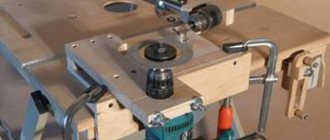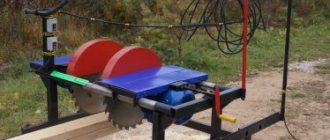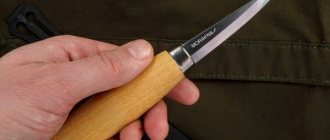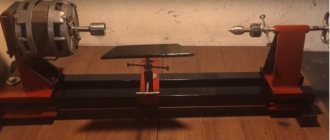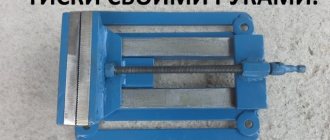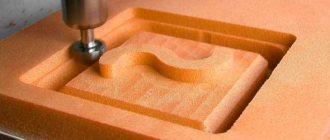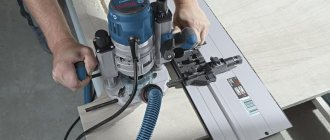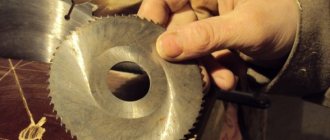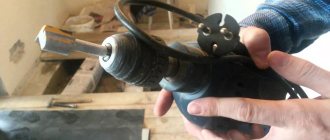Working with various materials requires the use of high-quality cutting tools. Most of the required types have standard parameters and are freely sold in stores, but some samples have specific sizes or shapes. They are not produced or are extremely rare. To a greater extent, the question concerns cutters that have many profile options, varieties or types of design.
Finding the right type can take too much time, so sometimes there are no other options other than making a cutter at home.
Will need
We only need two M8 bolts and a washer with an outer diameter of 35-45 mm. By the way, the size of the bolt depends on the problem being solved. In our case, we select the future tool for a Forstner cutter to match the holes for a small ball bearing. It must be secured flush with the plane of the base. We will also make a clamp for pressing the element into the wood.
So, let's arm ourselves with power tools:
- Grinder (angle grinder) with cutting and grinding abrasive discs.
- Drill.
- Electric welding machine.
- Vertical drilling machine.
The hand tools we will need are: a file, a marker, and a caliper. Well, a workbench with a vice can be found in every workshop.
This is interesting: Making a stand for a drill with your own hands: instructions, drawings, video
What is needed for making
You can make a router with your own hands from a drill using any available materials. The main requirement: the structure must be durable, the presence of backlashes and distortions is not allowed, the electric drill must be securely fastened.
To make parts you can use:
- Chipboard or multilayer plywood with a thickness of 12 mm or more;
- cutting boards of suitable thickness;
- wooden bars.
It is also possible to use other materials. For example, you can use metal. A base made of thick plexiglass or acrylic is a good idea. The surface being treated will be visible through such material.
The parts are connected using self-tapping screws. For reliability, all fixed joints can be glued with any suitable glue (carpentry glue, PVA, etc.).
To fasten moving parts, you may need bolts or studs with a diameter of 6 - 8 mm . They will need nuts, both regular and wing nuts. Some connections may require washers. It is possible to use furniture fittings: guide mechanisms, various fasteners, and so on.
Useful tips
To get good results when working with wood, you should follow safety rules. You need to make sure:
- The cutter is fixed in a collet.
- The accessory corresponds to the power of the power tool.
- When using an edge router, you must ensure that the bearing or guide ring is installed.
- The correct insertion depth is set (when using a submersible device, this can be seen on a special limiter).
- The workpiece must have support.
- To reduce the amount of dust when working, use a vacuum cleaner.
The use of attachments specially designed for the material being processed can significantly improve the result.
And depending on the angle of their use, a different cut is obtained. Experienced craftsmen often make such attachments themselves. To do this, the cutting edge is sharpened at the required angle. But if you don’t want to waste time on homemade cutters, then you can easily buy them; the range in stores is quite wide. It is quite easy to make accessories for a wood router with your own hands, and their benefits are great. This option is suitable for those who do not want to spend a lot when buying a tool or when the necessary equipment is not on sale. And the use of a router with furniture templates significantly reduces assembly time, and also improves the quality of work and prevents mistakes.
Originally posted 2018-07-04 08:29:39.
DIY cutter: making homemade wood cutters
The question of how a wood cutter can be made with your own hands worries not only home craftsmen who do their own carpentry and modeling, but also professional finishers. And the main thing here is not only the desire to save money, but the fact that serial tools for woodworking, which today are easy to purchase in specialized stores or on construction markets, often do not have the required configuration of the working part. That is why specialists and home craftsmen who use such a tool have to modify its serial models or make it from scratch, using cylindrical steel blanks.
Homemade wood cutters
Preparing the template
Stage 1. Sketching.
Stage 2. Cut out the shape.
Stage 3. Making the mold.
The simplest clamp for pressing
We will make this device from the same M8 bolt and a washer of suitable diameter. We place the bolt vertically on a metal surface, providing mass contact for electric welding. We place the washer on top in the center of the bolt head, holding it with pliers. We scald the center with an electrode, filling the area of the inner hole of the washer.
We clamp the resulting clamp in a vice and clean it with an angle grinder. The back part can be passed with a cleaning brush attachment for a drill.
We insert the finished clamp into the chuck of a vertical drilling machine, and try to press the bearing into the wood. This simple device will save you unnecessary effort and allow you to accurately handle such tasks.
How to make a cutter
Milling cutter is a general name for a wide group of cutting tools. There are two main types:
- on wood;
- on metal.
There are many types of cutter designs used to perform different technological operations:
- Whole.
- Composite (prefabricated).
- End.
- End face.
- Shaped.
- With replaceable plates and others.
The production of cutting tools is a high-tech process that is demanding on the quality of the material. For example, the production of end mills consists of several stages:
- Turning of a workpiece (shaping).
- Milling teeth.
- Processing of cutting edges (sharpening and backfilling).
- Heat treatment of the material (hardening, tempering, other operations resulting in a high-quality metal structure).
To manufacture other varieties, similar or other operations are performed, determined by the type and design of the tool. Homemade cutters are only modifications of ready-made samples.
Attention! The manufacturing technology of cutting tools is complex and requires the use of precise equipment. At home, production “from scratch” is impossible; only processing of the finished tool, changing its shape or size is available.
The need to use one type or another, to obtain a certain profile or size of the cutting organ, forces you to decide the issue yourself. Let's look at how to make a cutter with your own hands at home.
Homemade wood cutters
Making a wood cutter with your own hands is possible if you have the appropriate workpiece and a machine where it will be installed. At home, an electric drill or a hand-held milling machine is usually used. The most affordable option is to change the shape of a regular metal drill, but other methods can also be used.
Let's look at how to make a wood cutter from a drill. Depending on the purpose of the tool, you will need a workpiece (metal drill) of a certain size. If you plan to manufacture a shaped cutter, then the diameter of the workpiece must be equal to the maximum diameter of the final product. Manufacturing consists of two stages:
- Giving a profile.
- Creating a shank.
Both operations require the use of industrial equipment. In any case, a lathe will be required to make the shank. The hand router collet is designed for a diameter of 8 mm (there are options for 6 and 7 mm). Therefore, for large drill diameters, the shank should be prepared before creating the profile. This will eliminate beating, which is dangerous when processing wood. The easiest way to create a profile is by grinding. First you need to make a template, according to which you need to constantly check the status of the profile. To work, you will need a grinding machine (emery), a grinder or a cutting wheel mounted in the chuck of an electric drill.
To create replacement plates for the milling head, either ready-made samples are used, which are given the desired shape, or blanks made of high-quality metal. The profile is created by grinding on a machine at hand.
The final operation is backing. This is the process of setting a specific cutting edge angle to ensure that the back of the edge does not contact the workpiece.
Important! Backing is a rather labor-intensive process, but necessary; it is the only thing that gives the cutter the ability to work normally.
DIY metal cutter
Making cutters for metal at home is limited to regrinding existing tools, changing the profile or diameter of the cutting part. More active intervention will require the use of industrial equipment, as it will be necessary to perform complex procedures:
- Tempering of metal (a procedure reverse to hardening).
- Machining, including shaping, sharpening, backing).
- Hardening the cutter.
It is almost impossible to carry out these actions efficiently at home. In addition, work of this kind requires considerable professional training and experience, which not everyone has. Therefore, they are limited to only available procedures that involve minor intervention in the original state of the workpiece.
Making cutting tools at home requires the necessary equipment and suitable workpieces. In addition, you must have skills and experience, otherwise you can end up with a very dangerous product that can ruin the surface being processed and harm the craftsman himself. It is not recommended for an untrained person to carry out such work; it is better to seek help from a specialist.
This is interesting: Metal burrs: types and application features
Production of milling cutters: features of technological processes
The production of cutters is a complex and multi-stage process that begins with the formation of forgings.
Their primary turning is carried out on rotary lathes. This is followed by more precise, but still rough processing of the workpieces. Before the main operations, they are hardened in a furnace and then tempered: this procedure helps strengthen the metal. Then comes the turn of more “jewelry” actions. All surfaces of the cutter and its cutters are ground with a minimum allowance of no more than 3 mm. After this operation, another heat treatment follows: heating to +550 degrees and natural cooling. Despite the fact that the workpiece does not undergo any changes externally, this stage is very important: during it, the internal stress of the metal is relieved.
After cooling, the part undergoes a series of mechanical operations: surface grinding, milling and final processing - bringing it to the required dimensions. To obtain cutters of increased hardness, their surface is additionally saturated with nitrogen, which significantly extends the service life of the tool.
Required Tools
Production does not require anything special. We will prepare the necessary materials and tools for the work:
- Small grinder with a circle of 125 mm;
- A piece of I-beam 180 mm long, 20-25 cm, or a sheet of iron 5 mm thick;
- Cutting disc;
- Cleaning disc;
- Cord brush for angle grinders with metal bristles;
- Chalk;
- Vise;
- Round bit with a diameter of 40 mm for drilling holes;
- emulsion coolant;
- 10 cm of square pipe 25*25 mm and 50 cm of profile 20*20 mm;
- 2 extended nuts and 2 regular nuts with a diameter of 8 mm, 2 bolts 8*40 mm;
- A piece of sheet iron 1-1.5 mm thick;
- Chuck for drill 1.5-13 mm with threaded connection;
- Tap M14;
- Clamping bolts with wings 8*20 mm - 2 pcs., 2 nuts 8 mm.
- Drills 8 and 10 mm;
- 2 bolts 8*10 mm.
Do-it-yourself active cutter for a walk-behind tractor
Typically, an active cutter for a walk-behind tractor is sold complete with the walk-behind tractor. But sometimes you need to get the job done using specialized cutters that are not sold anywhere. In this case, you need to make cutters for the walk-behind tractor yourself.
In this case, you can go two ways: make the cutter yourself or order production from a master. The first option is quite labor-intensive. But a little time and money will be spent on manufacturing the cutter, as well as the cost of materials.
The second option has a number of advantages: the master has all the necessary tools and materials, and as a result the cutter will be more practical.
First you need to think about the functionality and design of the cutter. To do this, you should familiarize yourself with the analogues. To achieve maximum functionality and safety, all design details must be taken into account. If this is not taken into account, then the cutter will not do the necessary work, and all the work on its manufacture will be a waste of time.
You need to prepare the necessary materials after you have prepared the drawings. If the cutter design contains figured or pobedite elements, their production is ordered in the workshop. And other elements are bought in the store or those that are available are used.
After all the parts are made, it is necessary to assemble a normally working cutter, which not everyone can do. Assembly must proceed strictly according to the drawings, without any deviations in the design. Otherwise, the cutter will constantly move to the side, which will greatly complicate the work.
After the cutter is assembled, you need to test its operation. If the need arises, we alter the cutter so that it does the required job.
Milling cutters according to customer drawings
The release of any batch of cutters is preceded by a design stage.
As a rule, customers come to us with already developed drawings, thereby significantly reducing production costs. Our technologists just have to read the documentation, check the drawings, check the correctness of the technical calculations, and if all the calculations are correct, transfer the project to direct production. But even if you don’t have technical documentation on hand, this is not a problem: we will produce standard cutters according to standard drawings, and for the production of non-standard tools we will offer the services of our design engineers.
Manufacturing Features
A homemade part of this type has certain restrictions on the materials that can be worked with when using it. Creating cutters for a hand router usually involves working with steel, which belongs to the soft category. For this reason, such a device allows you to work perfectly with wood, but if the material is very hard, then the effectiveness of the device is significantly reduced.
To create a homemade cutter, scraps of reinforcement or steel rods are usually used. Sometimes it is made from a drill. If the reinforcement is the base, then its ribbed coating will need to be leveled using a lathe.
First we need to make the shape of our future cutter.
- Using a pencil and ruler we draw knives. If the diagram is not at hand, then you can find examples on the Internet or in the relevant literature, then simply redraw the required profile and follow the further algorithm.
- Now you need to directly cut out the shape. Depending on how many knives we need as a result, it is necessary to count out the required number of sheets and, having grabbed them, carefully cut out the shape of the future product, without catching the pair of load-bearing sides of the knife, as well as the tip.
- After this you can start making the form. Using an adhesive composition, you will need to glue the template to the workpiece and carefully saw it off using a grinder. It is important to remember that not only the tip should be preserved, but also the side parts. So when working with an angle grinder you will need to be as careful as possible and take into account the dimensions of the product.
Manufacturing of the product
Stage 1. Preparation for sharpening.
For this process we need a stone disk like the one in the photo. Who would be sorry to use new ones for this task - you can get them already, so to speak, used ones. After all, in the process you will have to slightly change the radius of the wheel so that when working on a stand, the product will end up with the desired shape. To do this, you should use “balls”, which will help you quickly bring the stone wheel into the desired shape.
Stage 2. Making knives.
Using the same stand, we cut out the shape we need according to the template. After the wheel became the desired shape (previous stage), this became much easier to do. Total: the product has become the shape we need. What's next? Next, we sharpen it to such an extent that the metal begins to bend slightly inward - this is what should serve as a signal that it is necessary to stop the process.
Stage 3. Formation of the finished product.
So, the final stage is formation. The knives that we obtained in the previous stages need to be inserted into the empty recesses on the cutter. At this stage, it becomes clear why it was necessary to observe the proportions of the sides at the previous stages. Carefully insert the knives all the way into the cutter and voila! – the product is completely ready for use, and the funds spent are minimal.
The period of operation of these homemade knives may vary, but according to statistics, it significantly exceeds the accessory knives included with the product, which require constant sharpening and attention during operation.
Observe the boundaries of the product according to the template, strictly follow the above instructions, and lo and behold - in no more than half an hour you will have at your disposal a high-quality product for a minimal amount.
Video: DIY woodworking cutters.
Carbide cutter – component of machine tools
Carbide cutters: area of use, design features
We all need to do some work related to metal processing from time to time. This is especially true for owners of country houses and dachas. Drills and cutters made of hard alloys are used to make holes in metal parts and process metal surfaces.
Carbide cutters are used in most cases for processing various groove holes, as well as when working with metal products. Moreover, such products of the end variety are an integral part of the machines themselves. The wide range of all kinds of cutters, which differ in their design, size and scope of application, is amazing.
It should be noted that when choosing a product, you should know what the component will be used for in the future. For example, carbide end plates are subjected to perpendicular type surface treatment; angular - process inclined products, etc.
Wide variety of carbide cutters
All carbide cutters have a high degree of reliability and resistance to mechanical factors. Mostly for their production, materials with a predominance of tungsten are used, thanks to which it is possible to process hard and heat-resistant surfaces.
The main parameters by which cutters differ:
- form;
- diameter;
- dimensions;
- design.
Nuances of equipment selection
Cast iron is processed at low speeds of the cutting tool with low feed. The chips formed are fine, like dust. To work with such material, metal cutting disc cutters GOST 2678-93 are suitable. When cutting grooves according to accuracy class 4 and higher, a slotting tool is used.
The selection of grooves in parts such as shafts made of carbon and high-alloy steels is carried out on milling and gear cutting machines using disk cutters with brazed plates of the appropriate configuration.
The tool can be used on two-column horizontal milling machines if it is necessary to make grooves on the side of a large part. The area of use of discs with teeth is wide.
How to make a wood lathe with your own hands: drawings and technology
The easiest way to make a tool yourself at home is to construct a lathe or milling machine from a drill or electric motor removed from another tool. This process is not that complicated, so every master can handle it. To do this, you will need an electric motor, the power of which does not exceed 500 W, and available materials. A drill can also be used as a drive. Of course, making a lathe will require some skill.
The device of the tailstock of a homemade wood lathe
To build the machine, the following elements are required:
- metal frame;
- electric motor;
- handyman;
- tailstock.
It wouldn’t hurt to get a drawing that will help you navigate the dimensions and correctly manufacture all the structural elements for its subsequent assembly.
How to make a homemade drilling machine with your own hands with a motor
First you need to prepare the electric motor shaft. To do this, a faceplate is installed on it; a steel center with a thread is also suitable. Installation of the second center is carried out in the tailstock tube. To make the frame, you will need a pair of corners measuring 5x3 cm, their length is 15 cm. A motor is attached to the frame using a bolted connection.
An example of a homemade drilling machine
Note! The central part of the tailstock must coincide with the middle of the electric motor shaft.
At the next stage of making a homemade machine, you assemble the headstock yourself. This element is formed from a pair of horizontal and a pair of vertical corners. A pipe intended for the spindle is attached to it. You need to insert a bolt into it, the diameter of which is 1.2 cm. First, its head is sharpened at a right angle. Thus, the central part of the spindle is designated. After this, the headstock is installed on the bed. On the top post, which connects to the horizontal corners, it is necessary to secure the tube by welding.
To make a tool rest, you need to take a steel rod with a chamfer. This element must also have a hole that will be used to secure the support ruler. It is necessary to vertically weld the tube with the locking screw to the long angle. Then the tool rest rod is inserted into it.
The motor rotor on which the faceplate is attached will be used as the headstock spindle. You need to make several holes in it. A fork will be inserted in the central part. The holes along the edges are intended for fixing the part with screws.
Even with the help of simple tools you can create interesting wooden products; for this you need to study the technology of working with the tool and practice
How to make a wood lathe from a drill with your own hands
Having a workbench with a strong and flat working surface at hand, you can build a lathe without resorting to building a bed. The electric drill in this case will serve as a rotary drive and headstock. According to the simplest drawing of the machine, it is enough to fix this tool on the surface of the workbench through the neck. Clamps and a clamp are suitable for fixing.
Next you need to make a stop that will act as a tailstock.
This element is mounted opposite the drill. To create it, you can take two blocks of wood and an adjusting screw, sharpened at one end to a cone. If you intend to use the machine for processing massive wooden workpieces, then it is advisable to fix the stop on the table using clamps.
To make a tool with your own hands, inexpensive materials are enough. A drill-based lathe can be used to turn various parts:
- door handles;
- structural details of the staircase;
- decorative items, etc.
Using a workbench with a durable and flat working surface, you can make a lathe from a drill with your own hands
Note! The machine with a wooden clamp is suitable exclusively for processing wood blanks. It is not allowed to use such a tool for working with metal.
To expand the functionality of the tool, its design can be supplemented with attachments and other devices that can improve the quality of work.
Such improvements include:
- winding on transformers;
- applying a coloring composition over a rotating part to create patterns;
- applying spiral notches to the workpiece, etc.
Installing a special attachment in the form of a copier will allow you to use the machine to create a whole series of identical parts or products according to a template.
An example of a multifunctional homemade woodworking machine from a drill
Manufacturing process
In everyday life, a vertical manual router is often used. It has the easiest design to repeat. It is enough to make a stand with a mount for an electric drill, and the device is ready to perform simple operations. An example of such a homemade unit is in the photo below.
The process of making such a base is quite simple:
- The first part that is best to start with is the base (sole). It is necessary to cut the workpiece into a round or oval shape.
- Next, make a hole for the cutter. It should be offset relative to the center of the part, taking into account the thickness of the side post.
- Depending on the dimensions of the electric drill, a stand of the required size is made and secured to the base with self-tapping screws or furniture fittings.
- The rigidity of the fastening is ensured by a spacer (kerchief). The inner sides of this part must have an angle of strictly 90°.
- The next element is the drill mount. You can use a pipe clamp, as in the photo, or make a clamp from wood or plywood and secure it with self-tapping screws.
- As an additional fixation, a stop is installed above the drill.
This option is suitable for doing rough work or will serve as a temporary alternative to a full-fledged tool. To perform more precise operations, you will have to develop a more complex design.
There is nothing stopping you from equipping your “homemade product” with adjustable cutter reach or the ability to change the angle of inclination. It is possible to use a drill in a tabletop milling machine. To do this, the electric drill is installed vertically under the working surface.
Copy rings and templates
Devices for a hand router, such as copying rings, are a round plate with a protruding shoulder that can slide along the surface along the template, thereby ensuring the exact trajectory of the cutter. Often this element is attached to the base of the workbench. There are several ways to install it:
- Screwing the ring into a threaded hole.
- Installation of special antennae of the device into the holes on the sole.
If you have such a device for a manual router as a template, you can also achieve more accurate and efficient work. The said element is fixed directly to the workpiece itself with double-sided tape, after which both parts of the device are pressed to the machine using clamps. Upon completion of the work, experts recommend checking the condition of the ring - see whether it is securely pressed against the edge of the template or not.
Another feature of the tool in question is the ability to process not the entire edge, but only its corners. At the same time, some devices for a hand router allow you to make curves of four different radii at once. Thus, the process of cutting material using a template is an excellent way to cut grooves for a part.
Cutting grooves on narrow surfaces
The home handyman is often faced with the need to cut grooves for a door lock or hinges. As a rule, a chisel and a drill were used for this. But this procedure can be carried out much faster and easier if you use a milling cutter with special equipment. This design allows you to easily create grooves on narrow surfaces and is a flat base that is mounted on the tool.
And also two pins are additionally installed, which ensure the movement of the cutter in a straight line.
The main requirement for this design: the pins must be located in the center of the material being processed. If this condition has been met, then the groove will be located strictly in the middle. To shift the direction of processing, it is enough to put a sleeve of the required size on one of the pins. When using such an attachment, you must ensure that its edges are pressed tightly to the sides during processing.
If you need to cut a groove on a narrow surface, but there is no necessary equipment, then this problem is solved with the help of two boards. They are attached on both sides of the product in one plane. And the power tool itself is fixed with a parallel stop.
The use of such an attachment for a door hinge router allows you to:
- Make the most accurate notch without spending a lot of effort.
- Minimize the possibility of an error, the probability of which is very high without using a template.
Tools and materials
So, to create a wood cutter with your own hands, you will need to have a pair of M8 bolts, as well as a washer with an outer diameter of about 4 centimeters. Naturally, the sizes of the bolts will depend on the problems that need to be solved. If we are talking about a tool for a Forstner cutter made from a drill, then you should take into account that it must have holes for a small ball-type bearing. It should be attached flush with the base plane. In addition, you will need to make a clamp, which will allow you to press the element into the wood.
The tools you will need to have on hand are:
- drill;
- vertical drilling machine;
- electric welding machine;
- angle grinder with abrasive discs of grinding and cutting type.
If we talk about hand tools, you will need:
- calipers;
- marker;
- file;
- Desktop;
- vice.
Expanding the functionality of the router
Additions for a router should solve one problem - to hold the tool in the desired position when processing material. When purchasing an expensive machine, frequently used milling accessories are included in the kit. But for cheaper or highly specialized options, you have to buy them separately. The design of such additions is quite simple and does not require a drawing for self-production.
Rip fence
This addition allows for straight cuts and is often used when working with wood. It allows you to work on any surface, not just your desktop. The grooves are cut with its help.
The design of the add-on consists of:
- Rods that are attached to the body of the instrument.
- A fine adjustment screw is used to adjust the gap between the cutter and the surface.
- A locking screw, with its help, the rods are secured in the desired position.
- Overlays, on which the tool is placed.
The design of the base is quite simple and you can make it yourself.
To prepare an addition to the work you need:
- Install the rods into the holes of the tool body and secure them with a screw.
- Set the required distance between the surface and the cutter.
Additionally, by placing a specially treated block (with one rounded edge), you can significantly increase functionality and make cuts along a curve. This part is installed between the tool and the surface. Due to its unstable position, it must be handled very carefully.
Guide rail
The addition is used to move the tool over the working surface at any angle, which is different from the rip fence. The design makes it easier to mill holes located at a distance from each other. Special clamps hold the device on the surface being treated. If they were not included in the delivery set, then clamps are used. Some options are equipped with an adapter to adjust the direction of movement of the tool.
The design is best used together with a power tool whose support platform is adjustable. This will help eliminate the problem when the tire and the cutter are located in different planes, which happens when the tool and the workpiece are close.
The design is quite simple, but very effective. If you have minimal skills in working with the tool, it can be easily done at home. To do this, just take a block, which is attached to the surface to be treated using a clamp. If you fix the structure on two or more bars at the same time, you can make a groove in one go. The main disadvantage is the difficulty of accurately fixing the structure in relation to the future cut. But the following additions lack this.
The first fixture consists of a sheet of plywood and a guide connected together. It is used to work with blades of the same size.
When you need to use cutters of different diameters, a different device is suitable. Its main advantage is that the tool is in contact with the entire lower part of the material. The guide has a board (folding) that holds the power tool in the desired position to the material.
Step-by-step instruction
So, let's move on directly to considering the instructions for making the above-mentioned device.
- First, use a caliper to measure the residual distance on the bolt head relative to the bearing being installed. If we are talking about an M8 type bolt, then the size of the hat circle in this case will be 1.27-1.3 cm. The diameter of the handle is about 1.16 cm, which makes it possible to easily clamp it in the vast majority of modern drill chucks.
- The cap should be adjusted to the bearing diameter. It is this area of the bolt that will represent the working part of the cutter.
- For marking, it is better to use a thinner contrast marker; the main thing is that the marks that will be applied with it are easily distinguishable on the metal. Now we apply the markings of the cutter's burrs. This solution will allow her to get rid of shavings without much effort.
- After this, we clamp the bolt in a vice. Using a cutting wheel, we use a grinder to create slits on the cap.
- We measure the bearing diameter. To work the head of a bolt with a faceted surface to a circle, you should transform the drill into a lathe. To do this, you need to clamp it in a vice, and then firmly attach the bolt in the chuck precisely in the center.
- Now you should fix the drill key at a constant operating mode, after which you can begin processing the bolt head. This process must be controlled at all stages of its implementation in order to prevent the center of the bolt from moving, which can cause a violation of the uniformity of the operated teeth.
- After this, you should install an abrasive disc on the grinder for grinding and process the edges around the circumference. The end area of the cutter should also be removed a little, leaving only a slight sharpness in the center. This element is of great importance, because this type of cutter will first find the center when working, and only then will the material be triggered by the rims and edges of the cutting type. Here you can carefully refine everything using a file, so as not to accidentally cut off more than is necessary during the grinding process.
- The cutter itself will be almost ready. All that remains is to give the cutting edges the required shape, and then sharpen them a little.
For greater efficiency, it would be useful to make the simplest clamp for pressing. Therefore, the instructions for creating it also need to be considered.
- This device is also made from an M8 bolt and a washer of suitable diameter. The bolt should be placed vertically on a surface made of metal so that the required contact for electric welding is ensured. The washer must be installed in the center of the bolt head. To make this job easier, you can use pliers. After this, the central part will need to be treated with an electrode to fill the area of the inner hole of the washer.
- Now you need to clamp the clamp, which was obtained as a result of the above actions in a vice, and then clean it using a grinder. You can walk along its back using a special brush attachment for a drill.
- At the final stage, all that remains is to install the finished device into the chuck of a vertical drilling machine, after which you will need to press the bearing into the wood. Such a simple “gadget” will eliminate a number of inconveniences when using a homemade cutter.
By the way, an end mill for wood can be made not only from a drill, but also from a tube with thin walls.
In this case, the algorithm for creating it will be as follows:
- in this case, the workpiece will be a piece of pipe with a length of about 20 centimeters;
- on the side where the cutting edge will be located in the future (somewhere at a distance of 2 cm from its intended location), oval-shaped grooves should be made on both sides of the pipe;
- the future cutting part of the cutter itself will need to be shaped into a cone - it is ground at an angle of about 2-3 degrees;
- when clamping the workpiece in a vice, a cross-shaped cut should be made at its end area - this can be done using an angle grinder;
- From the side of the cutting part, you need to make grooves on the workpiece - right up to the oval holes made earlier.
Types of homemade cutters for wood processing
- Cone cutters, processed at medium and high speeds, are used to remove excess wood from the end elements of the workpiece. The best option for making this type of tool yourself is a milling cutter from a drill.
Such a cutter from a drill is made at home as follows: the tool is cut closer to its shank (from half to a quarter of its length), then each cutting edge of the cut drill is ground down to 1/2 - 1/3 of its diameter. If the cutting edges are ground down to a large amount, then not only will its body be exposed, but it will also lose its cutting properties. It is difficult to restore the cutting edges of homemade wood cutters, which have a spiral shape, with your own hands.
From a drill you can make cutters with different working heads
An end-type wood cutter can also be made from a thin-walled tube. How to make a cutter from such a blank? The following recommendations should be followed.
- A piece of pipe is taken as a workpiece, the length of which is 15–20 cm.
- From the side of the future cutting edge (at a distance of 2–3 cm from it), oval-shaped grooves are made on both sides of the pipe.
- The future cutting part of the wood cutter is given a conical shape, and it is ground at an angle of 2–3°.
- Having clamped the workpiece in a vice, a cross-shaped cut is made on its end part, for which an angle grinder is used.
- From the side of the cutting part, grooves are cut on the workpiece - up to oval holes.
- Using a homemade end mill made from a thin-walled tube, you can create blind or through holes in wood products. In this case, the inner surface of the blind holes must be refined using a chisel.
Many home craftsmen are interested in the question of how to make a large-diameter cone cutter with their own hands. It should be borne in mind that it is not easy to make such a tool for woodworking; for this you need to use special blanks and complex metal-cutting equipment.
Adviсe
Let's talk a little about tips that should be taken into account when creating homemade cutter models.
- To give the cutting area the correct configuration, you will need to use diamond-coated needle files or angle grinders with discs that are used specifically for working with metal.
- The edge for cutting should be sharpened at a 7-10 degree angle. If you make it sharper, then it will hold an edge poorly, which is why its cutting properties will significantly decrease.
- If a wood cutter made by yourself must have some kind of complex device, you can flatten it or bend it.
- When using an edge router, take into account that the guide ring or bearing is already installed.
- The cutter must be secured in the collet before starting work.
- The presence of additional accessories will help increase the power of the electric tool.
- The part to be processed must have some kind of support.
- When carrying out work, the correct insertion depth level should be set.
- To prevent too much dust from being generated when working, you can use a vacuum cleaner.
In general, it should be said that creating a wood cutter yourself is not difficult. True, it should be understood that in this way you can quickly solve some simple problem, because for hardware such as bolts, ordinary steel is used, not tool steel. This means that such a homemade cutter will quickly wear out. But its life can be significantly extended in a number of ways. Therefore, this solution has a place and should be used in cases where you really need to quickly acquire a pretty good wood cutter in order to get the desired result.
For more information on how to make a wood cutter with your own hands, see the following video.
Do-it-yourself router from a drill: a detailed guide
Situations often arise when you need to make a groove, carefully trim the edge of a board, or make a part of a complex shape. Typically this work is done using a router. In a well-equipped workshop, any tool and all the necessary machines are at hand.
But what if, for example, instead of a workshop there is a garage, and only a drill is available. You can resolve the issue at your nearest power tool store. But, as usual, it all comes down to either finances or the fact that the milling tool is needed only for a while, and then it will simply gather dust on the shelf. As you know, there is a way out of any situation, and specifically from this one - a do-it-yourself router from a drill.
Cone cutters
Wood cutters, the working part of which has a conical configuration, are used for processing surfaces of complex terrain. In particular, with the help of such cutters, finishing of grooves in elements of furniture structures is performed. To manufacture such wood cutters in production conditions, complex-shaped workpieces are used, which are problematic to process at home. Such a cutter can be made with your own hands from a drill, the working part of which is given the required configuration.
Due to the fact that a homemade wood cutter is used to process fairly soft material in several passes, there is no need to further strengthen the structure of the material from which such a tool is made.
Manufacturing options for cone cutters
What types of cutters are there?
First of all, you need to understand for what purposes the cutter is used. Usually distinguished:
- cutters for metal work;
- milling cutters for carpentry;
- specialized cutters for certain devices (for example, cutters for pedicure or manicure devices).
Let's consider each option. Milling cutters for metal work are classified according to several parameters:
Milling cutters for woodworking are distinguished by:
- type of construction - prefabricated, with replaceable edges, monolithic;
- purpose and processing method - groove, edge, seam, cone, fillet, figured, figured, combined.
Milling cutters for household appliances are distinguished by
- size of the nozzle and sharpening of the teeth;
- shape of nozzles;
- rigidity of the material.
